Step back in time and discover the captivating history of Yakushi-ji Temple, a magnificent 7th-century Buddhist complex in Nara, Japan. This monumental site showcases the country’s rich architectural and artistic heritage, with breathtaking structures like the Kondo and the national treasure East Pagoda. Beyond the visual splendor, the temple’s Yakushi Sanzon Buddha statues and Daikodo hall offer a glimpse into the profound spiritual teachings that have resonated within these walls for over 13 centuries. Explore the temple’s unique Zen influences and the remarkable journey of the revered monk Genjo Sanzo, and uncover the secrets that have endured through the ages.
Key Points
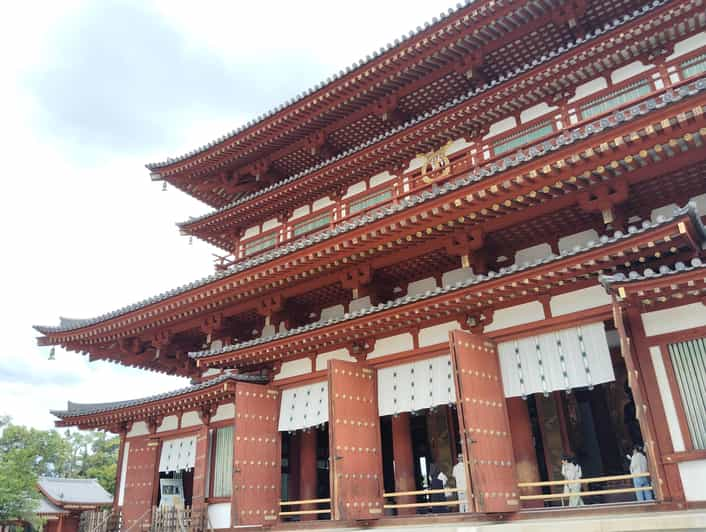
- Yakushi-ji Temple, a monumental 7th-century Buddhist complex in Nara, Japan, showcases the architectural and spiritual mastery of Japanese Buddhist heritage.
- The temple’s key structures, including the Kondo, East and West Pagodas, and the Daikodo, demonstrate the architectural sophistication and cultural significance of the Nara period.
- The revered Yakushi Sanzon Buddha statues, housed in the Kondo, exemplify the technical mastery and spiritual devotion of 7th-century Japanese Buddhist artisans.
- The Nara period East Pagoda, one of the oldest surviving examples of its kind, offers a glimpse into Japan’s rich Buddhist architectural legacy.
- The Daikodo and Toin-do within the temple complex played pivotal roles in the intellectual and religious life of the temple, fostering a deep understanding of Buddhist principles.
7th-Century Buddhist Temple Complex
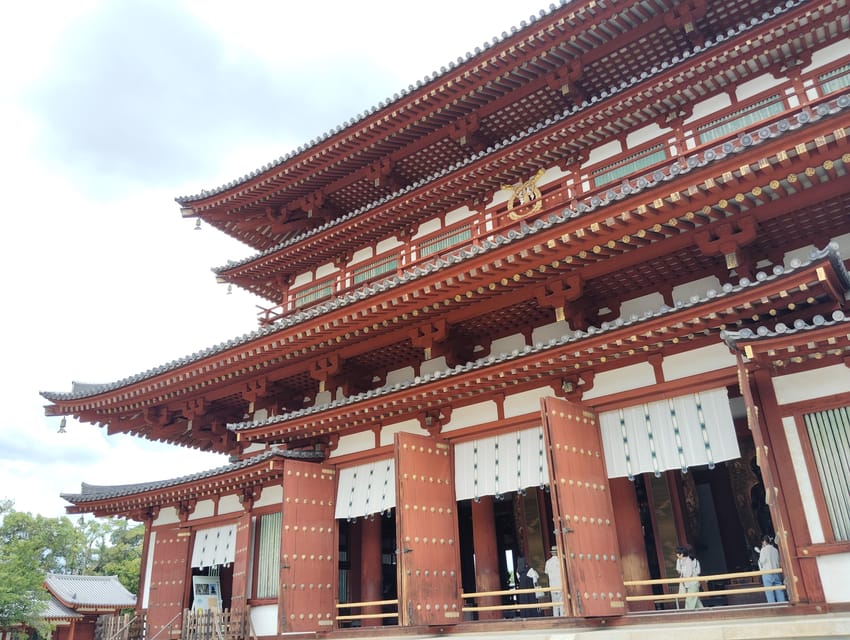
Yakushi-ji Temple is a 7th-century Buddhist temple complex located in the Nara Prefecture of Japan. It’s a monumental example of Japanese Buddhist architecture and spiritual devotion.
The temple’s key structures include the Kondo (Main Hall), which houses the Yakushi Sanzon Buddha statues, and the East and West Pagodas, with the East Pagoda being a rare Nara period example.
The Daikodo (Great Lecture Hall) serves as the largest building and a center for Buddhist teachings. Other notable features are the Toin-do (East Hall), Japan’s oldest Zen architecture, and the Genjo Sanzo-in Garan, which depicts the journey of the legendary monk Genjo Sanzo.
Here are more great tours and experiences we've reviewed in Nara
Monumental Japanese Buddhist Architecture
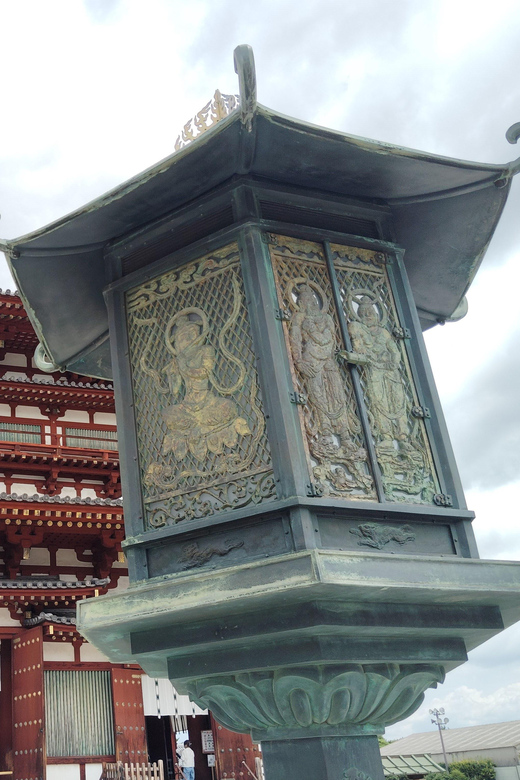
As a monumental example of Japanese Buddhist architecture, Yakushi-ji Temple’s structures showcase the spiritual devotion and artistic mastery of their creators.
The Kondo, or Main Hall, houses the revered Yakushi Sanzon Buddha statues, which are designated as National Treasures. The East and West Pagodas are iconic structures, with the East Pagoda being a rare Nara period example and also a National Treasure.
The Daikodo, or Great Lecture Hall, was the largest building and served as a center for Buddhist teachings. These architectural marvels demonstrate the profound significance of Yakushi-ji Temple in Japan’s rich cultural heritage.
Yakushi Sanzon Buddha Statues
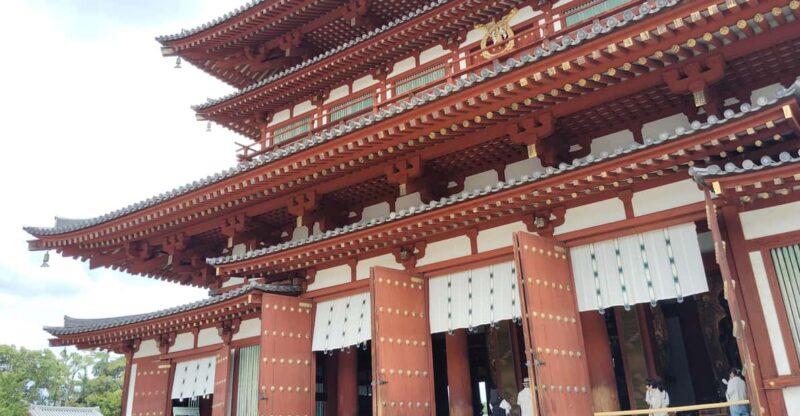
Three magnificent Buddha statues, known as the Yakushi Sanzon, are enshrined within the Kondo (Main Hall) of Yakushi-ji Temple. These National Treasures depict the Buddha of Healing, Yakushi Nyorai, flanked by two bodhisattvas. Crafted in the 7th century, the statues exemplify the technical mastery and spiritual devotion of early Japanese Buddhist art.
| Statue | Height | Material | Origin |
|---|---|---|---|
| Yakushi Nyorai | 190 cm | Gilt Bronze | Asuka Period |
| Bodhisattva | 160 cm | Gilt Bronze | Asuka Period |
| Bodhisattva | 160 cm | Gilt Bronze | Asuka Period |
The Yakushi Sanzon Buddhas stand as a testament to the enduring legacy of Yakushi-ji Temple, offering visitors a profound connection to Japan’s rich Buddhist heritage.
Nara Period East Pagoda

Alongside the magnificent Yakushi Sanzon Buddha statues, Yakushi-ji Temple’s East Pagoda stands as another national treasure from the Nara period. Built in the 7th century, this iconic structure is one of the oldest surviving examples of its kind.
The East Pagoda’s striking 5-story design reflects the architectural sophistication of the era, with its intricate details and harmonious proportions. As a rare Nara period pagoda, it offers visitors a glimpse into Japan’s rich Buddhist heritage.
Towering over the temple grounds, the East Pagoda serves as a testament to the artistry and spiritual dedication that defined Yakushi-ji’s enduring legacy.
More Great Thing To Do NearbyBuddhist Teachings at Daikodo

The Daikodo, or Great Lecture Hall, stands as the largest building within Yakushi-ji Temple’s expansive grounds. This grand structure served as a center for Buddhist teachings, where monks and scholars would gather to study and share their wisdom. The Daikodo’s spacious interior provided an ideal setting for these intellectual and spiritual pursuits.
| Daikodo Features | |
|---|---|
| Largest Building | Nara Period Treasure |
| Center of Study | Monks & Scholars |
| Spiritual Focus | Buddhist Teachings |
| Expansive Space | Ideal for Lectures |
This multifunctional hall played a vital role in the intellectual and religious life of the temple, fostering a deep understanding of Buddhist principles throughout the centuries.
Japan’s Oldest Zen Architecture
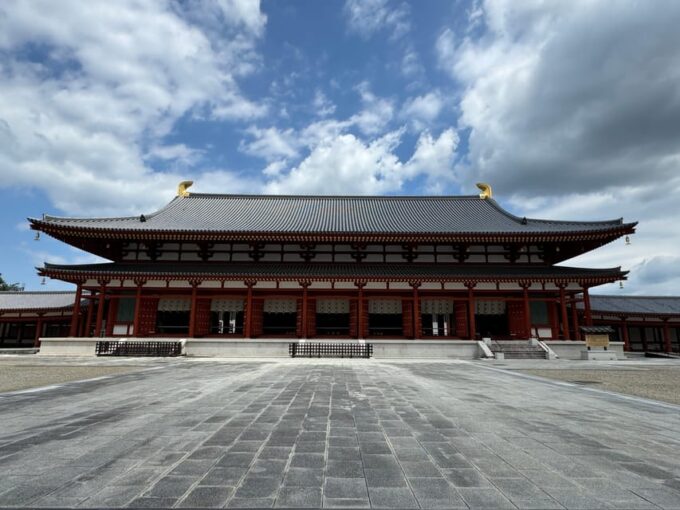
Yakushi-ji Temple’s Toin-do, or East Hall, stands as Japan’s oldest known example of Zen architectural design. Built in the 7th century, this remarkable structure predates the rise of Zen Buddhism in Japan by several hundred years. Its simple, minimalist style reflects the discipline and tranquility at the heart of Zen practice.
The Toin-do’s austere, understated elegance contrasts sharply with the ornate grandeur of the temple’s other buildings. Yet this unassuming hall played a vital role in Yakushi-ji’s history, serving as a center for Zen meditation and teachings. Today, visitors can experience the timeless serenity of this architectural treasure, a tangible link to Japan’s rich Buddhist heritage.
Journey of Genjo Sanzo

Genjo Sanzo, the legendary Buddhist monk, embarked on an epic journey chronicled in the classic Chinese novel "Journey to the West." His pilgrimage to India, in search of sacred Buddhist sutras, captivated the imaginations of generations across Asia.
At Yakushi-ji, the Genjo Sanzo-in Garan showcases artworks depicting the monk’s legendary odyssey. Visitors can enjoy the spiritual and artistic representations of Genjo Sanzo’s perilous voyage, brimming with fantastical creatures and extraordinary adventures. These striking artworks offer a glimpse into the enduring legacy of this revered figure, whose story continues to inspire Buddhist devotees and art enthusiasts alike.
Admission Savings and Booking

How can visitors save up to 20% on admission to Yakushi-ji Temple? It’s easy – simply reserve your tickets in advance. By booking your visit ahead of time, you’ll enjoy discounted entry fees.
Yakushi-ji Temple offers a convenient "reserve now, pay later" option, allowing you to secure your spot without any upfront payment. This flexibility ensures you don’t miss out on exploring this remarkable 1,300-year-old wonder.
The guided tour takes just one hour, but you’ll be captivated by the temple’s monumental architecture, iconic structures, and spiritual significance. Don’t miss your chance to discover the beauty of Yakushi-ji at a fraction of the regular price.
Frequently Asked Questions

Is Photography Allowed Inside the Temple Complex?
Photography is generally allowed inside the Yakushi-ji Temple complex, but visitors should check for any specific restrictions or guidelines. Some areas or structures may have limited or no photography permitted to preserve the sacred atmosphere.
What Are the Opening Hours and Seasonal Schedules?
Yakushi-ji Temple is open daily from 8:30 AM to 5 PM, with extended hours until 6 PM from April to October. It observes seasonal schedule changes, so visitors should check the website for the latest information.
Can Visitors Access the Temple Grounds Independently?
Yes, visitors can explore the Yakushi-ji Temple grounds independently. The temple is open daily, and self-guided tours allow visitors to discover the historic architecture and iconic structures at their own pace.
Are There Any Restaurant or Dining Options On-Site?
Yes, there are dining options on-site at Yakushi-ji Temple. Visitors can enjoy a traditional Japanese meal at the temple’s restaurant, which offers both indoor and outdoor seating with views of the historic temple grounds.
Are Guided Tours Available in Multiple Languages?
Yes, guided tours at Yakushi-ji Temple are available in multiple languages. Visitors can choose from Japanese, English, Chinese, and Korean tours to explore the temple’s 1,300-year-old history and architecture.
Recap
Yakushi-ji Temple’s enduring legacy lies in its magnificent architecture and the profound religious significance it embodies. Visitors can enjoy the temple’s rich history, from the awe-inspiring Yakushi Sanzon Buddha statues to the Nara period East Pagoda and the Toin-do’s Zen design. This 1,300-year-old temple complex offers a captivating glimpse into Japan’s vibrant Buddhist heritage and the intellectual and spiritual life that thrived within its walls.
You can check if your dates are available here:More Tour Reviews in Nara
- Private Nara Experience With Local Guide
- Taste of Nara A Guided Half Day Food Tour Tailored to Your Taste
- 7hr Private Guided Van Tour Nara & Matcha Farm
- Nara Private Custom Tour With Local Guide
- Nara: Half-Day Private Tour of 4 Must-See Spots & Deer Park
- Full Day Nara Deer, Temple, Shrine, Activities & Tea Ceremony
Not for you? Here's more things to do in Nara we have recnetly reviewed
- 5 Best Food Tours In Nara
- 4 Best Full-Day Tours In Nara
- 3 Best Private Car With Driver Services In Nara
- 3 Best Lunch Experiences In Nara
- From Osaka: Nara Private Customizable Day Tour
- Kyoto/Osaka: Nara Customizable Self-Guided Tour With Driver
- From Kobe: Nara Classic Private Tour With Car Pickup
- Nara: Visit a Tea Whisk Maker & Make Your Own Tea Whisk
- Nara: Visit a Tea Whisk Maker & Join the Unique Tea Ceremony
- Nara: Half-Day Private Tour of 4 Must-See Spots & Deer Park
- Nara: Customized Barhopping Tour – 3 Hours of Local Bars
- Nara: 1.5 Hour Private Kasuga Taisha Shrine Tour – World Heritage
